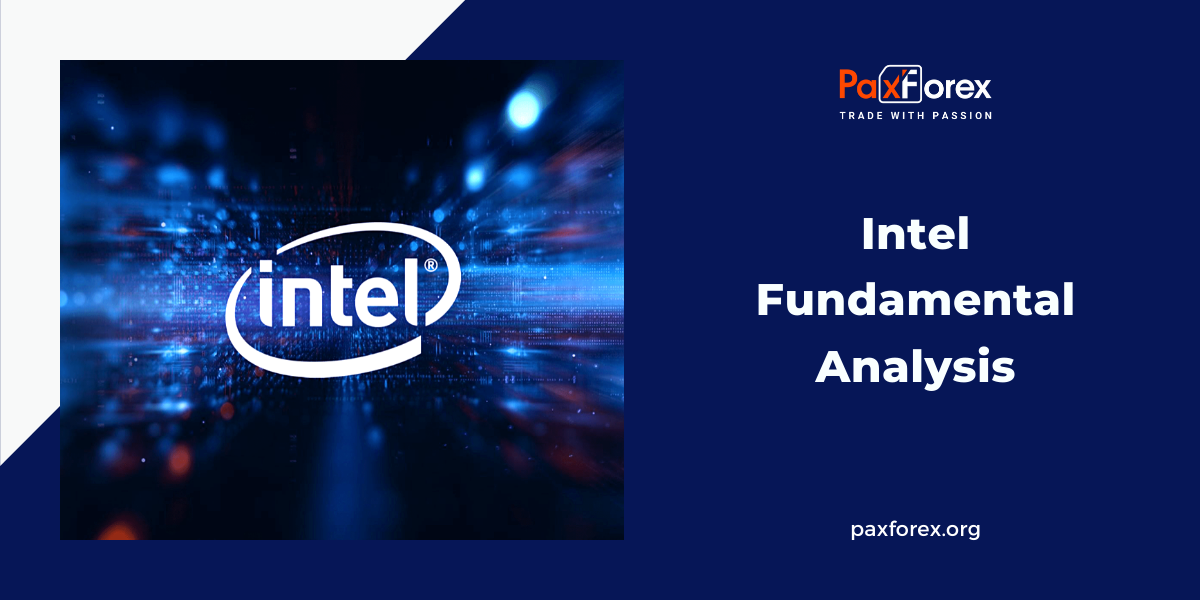
Source: PaxForex Premium Analytics Portal, Fundamental Insight
Intel, the world's largest maker of central processing units (CPUs) for PCs and servers, is often considered a stable investment for conservative investors. But its stock has fallen about 6 percent in the past four years, even as the Philadelphia Semiconductor Index has more than doubled.
Manufacturing mistakes, production delays, and stiff competition from AMD all held back Intel's growth. The company has also favored stock buybacks and cost-cutting measures at a time when it should have been focusing on fresh investments, and the change of three different CEOs in the past four years has been a wake-up call.
Should investors consider Intel a worthless investment and move on to more promising assets? Or should they still view the company as an undervalued stock on a U-turn at 14 times projected earnings? Let's look at both sides of this question.
"Bears" will tell you that Intel has become complacent over the years and has not upgraded its chip factories. Unlike "fabless" chip makers like AMD, who outsource their production to third-party foundries, Intel still makes most of its chips in its factories.
As a result, Intel has fallen behind Taiwan Semiconductor Manufacturing, also known as TSMC, in the "technology race" to create smaller, denser, and more energy-efficient chips. AMD, which uses TSMC foundries, then beat Intel in that race by producing smaller, more energy-efficient processors. Intel's ongoing foundry problems also led to constant delays, frustrating its longtime customers.
These mistakes, which largely occurred under former CEO Brian Krzanich between 2013 and 2018, handed a big chunk of the processor market to AMD. According to PassMark Software, between the second quarter of 2016 and 2022, Intel's global share of the x86 processor market declined from 80.6 percent to 64.1 percent, while AMD's share rose from 19.4 percent to 35.6 percent.
After Krzanich's sudden resignation in 2018, his successor, Bob Swan, immediately focused on wasteful buyouts and cost-cutting measures rather than aggressively pursuing TSMC. Swann even briefly considered following AMD's lead and becoming a fabless chipmaker before he was ousted and replaced by current Intel CEO Pat Gelsinger in early 2021.
Instead of moving to fabless production, Gelsinger has redoubled his efforts to expand and upgrade Intel's foundries to surpass TSMC in the technology race by 2025. He expects this ambitious plan to increase annual capital spending from $18.7 billion in 2021 to $27 billion (36% of estimated revenue) in 2022, and that spending will "grow above historical levels over the next few years."
Intel expects such aggressive spending to reduce adjusted free cash flow to negative levels this year, so share repurchases could be halted and dividend increases could be suspended. If the situation worsens, Intel could abandon the dividend entirely to save nearly $6 billion a year.
Intel would still have a hard time keeping up with TSMC, which plans to increase its capital spending to a record $40 billion to $44 billion this year. Gelsinger is desperately begging for big government subsidies to fill the gap.
Intel still expects its adjusted revenue to grow 2% in 2022, even as PC sales slow in the post-closing market, but it's also preparing for a 31% drop in adjusted earnings per share (EPS) as it ramps up its costs.
"Bulls," on the other hand, acknowledge that Intel faces a lot of near-term challenges, but they also believe that Gelsinger's turnaround plans will pay off.
They note that Intel is optimizing through the sale of its NAND memory business and the upcoming initial public offering (IPO) of its Mobileye automotive chip division. The company is also quietly outsourcing production of some of its chips (including discrete graphics processors) to TSMC to free up capacity for production of its high-end processors. All of these moves could free up billions of dollars in cash for the long-term expansion of its third-party foundries.
Bulls also believe Intel will win government subsidies in the U.S. and Europe, where many companies have become wary of the industry's over-reliance on TSMC and Samsung to produce new high-end chips.
To alleviate those concerns, Intel plans to open its foundries to outside customers in the future, potentially drawing away orders from TSMC, Samsung, and other third-party contract chipmakers. Such an expansion could also allow foundries to generate much more revenue on their own.
Finally, Intel is hitting back at AMD with new chips, such as the new "Alder Lake" processors, which roughly match AMD's smaller Ryzen processors in terms of performance while consuming more power. It's not a perfect or permanent solution to fight AMD, but it may help Intel stay afloat in the PC market for now.
Intel is not doomed, but its stock cannot be called undervalued. Its low price-to-earnings ratio reflects the company's slow growth and murky prospects, and it will likely continue to trade at a discount until it gets more government support and shows that it can catch up with TSMC.
Intel's downside potential at these levels may be limited, but investors should stick with more stable companies in this difficult market.
As long as the price is below 52.90, follow the recommendations below:
- Time frame: D1
- Recommendation:short position
- Entry point: 46.46
- Take Profit 1: 44.70
- Take Profit 2: 42.70
Alternative scenario:
If the level of 52.90 is broken-out, follow the recommendations below:
- Time frame: D1
- Recommendation: long position
- Entry point: 52.90
- Take Profit 1: 56.30
- Take Profit 2: 58.30













